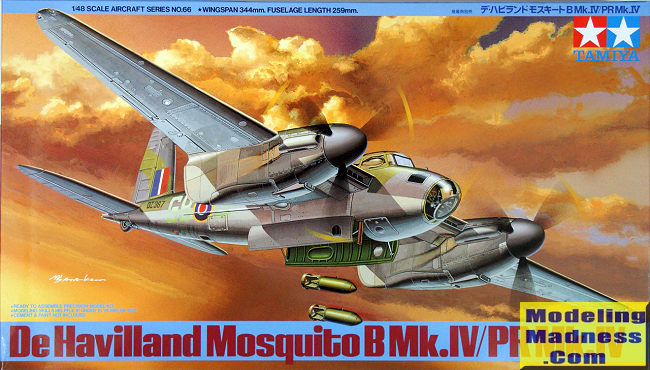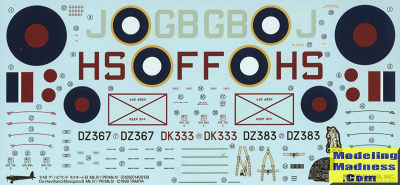
| KIT #: | 61066 |
| PRICE: | 2800 yen SRP |
| DECALS: | Three options |
| REVIEWER: | Scott Van Aken |
| NOTES: | 1999 tooling |

| HISTORY |
On 21 June 1941 the Air Ministry ordered that the last 10 Mosquitos, ordered as photo-reconnaissance aircraft, should be converted to bombers. These 10 aircraft were part of the original 1 March 1940 production order and became the B Mk IV Series 1. W4052 was to be the prototype and flew for the first time on 8 September 1941.
The bomber prototype led to the B Mk IV, of which 273 were built: apart from the 10 Series 1s, all of the rest were built as Series 2s with extended nacelles, revised exhaust manifolds, with integrated flame dampers, and larger tailplanes. Series 2 bombers also differed from the Series 1 in having an increased payload of four 500 lb (230 kg) bombs, instead of the four 250 pounds (110 kg) bombs of Series 1. This was made possible by cropping, or shortening the tail of the 500 pounds (230 kg) bomb so that these four heavier weapons could be carried (or a 2,000 lb (920;kg) total load). The B Mk IV entered service in May 1942 with 105 Squadron.
In April 1943 it was decided to convert a B Mk IV to carry a 4,000 lb (1,800 kg) Blockbuster bomb (nicknamed a Cookie). The conversion, including modified bomb bay suspension arrangements, bulged bomb bay doors and fairings, was relatively straightforward and 54 B.IVs were modified and distributed to squadrons of the Light Night Striking Force. 27 B Mk IVs were later converted for special operations with the Highball anti-shipping weapon, and were used by 618 Squadron, formed in April 1943 specifically to use this weapon. A B Mk IV, DK290 was initially used as a trials aircraft for the bomb, followed by DZ471,530 and 533. The B Mk IV had a maximum speed of 380 mph (610 km/h), a cruising speed of 265 mph (426 km/h), ceiling of 34,000 ft (10,000 m), a range of 2,040 nmi (3,780 km), and a climb rate of 2,500 ft per minute (762 m).
| THE KIT |
 Instructions
are typical Tamiya 'road map' style with Tamiya only paint references. The
interior color will need to be mixed if you are using Tamiya paints. The
decal sheet provides markings for three planes. Two B.IV bombers are dark
green/ocean grey on the upper side. The box art plane from 105 squadron has
medium sea grey undersides. The other from 109 squadron has black
undersides. The PR.IV from 540 squadron is overall pru blue. The
decals are nicely printed and include belt and instrument panel decals.
Instructions
are typical Tamiya 'road map' style with Tamiya only paint references. The
interior color will need to be mixed if you are using Tamiya paints. The
decal sheet provides markings for three planes. Two B.IV bombers are dark
green/ocean grey on the upper side. The box art plane from 105 squadron has
medium sea grey undersides. The other from 109 squadron has black
undersides. The PR.IV from 540 squadron is overall pru blue. The
decals are nicely printed and include belt and instrument panel decals. | CONCLUSIONS |
This kit has been built by the thousands and every one I've seen has been very nice. The kit is fairly inexpensive in the scheme of things and there is no reason why your next Mossie build should not be this one. I've seen these as low as $25.00 shipped as a 'used' kit.
| REFERENCES |
https://en.wikipedia.org/wiki/De_Havilland_Mosquito#Bombers
August 2019 Copyright ModelingMadness.com. All
rights reserved. If you would like your product reviewed fairly and fairly quickly, please
contact the editor
or see other details in the
Note to
Contributors. Back to the Main Page
Back to the Review
Index Page
Back to the Previews Index Page